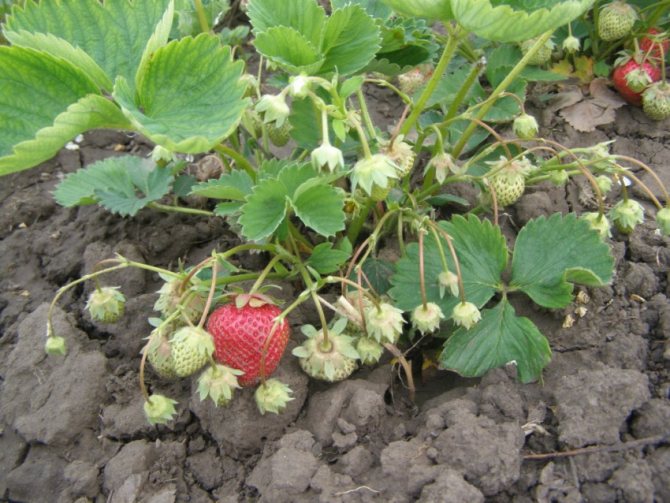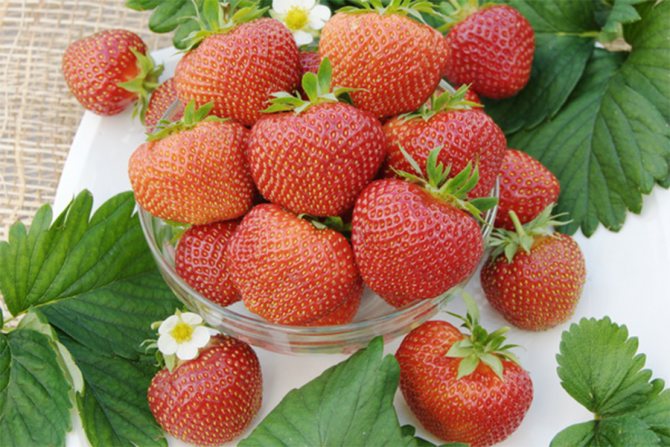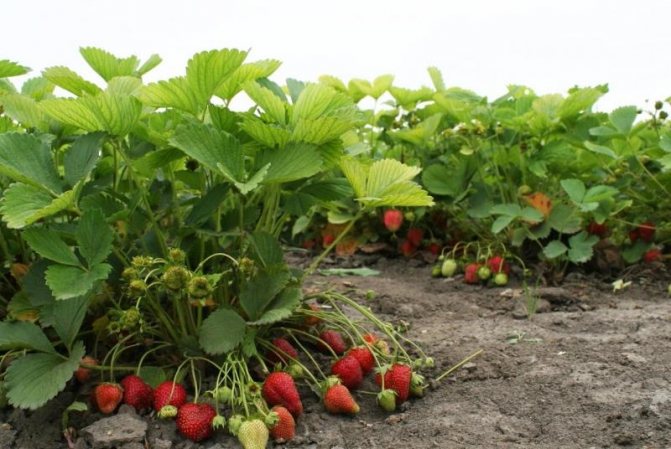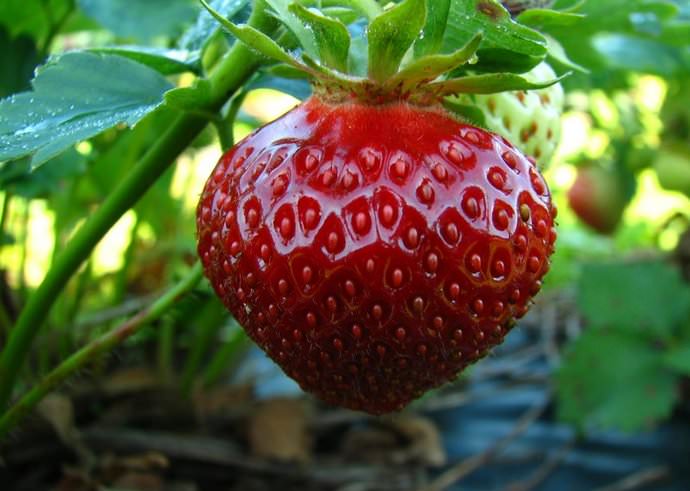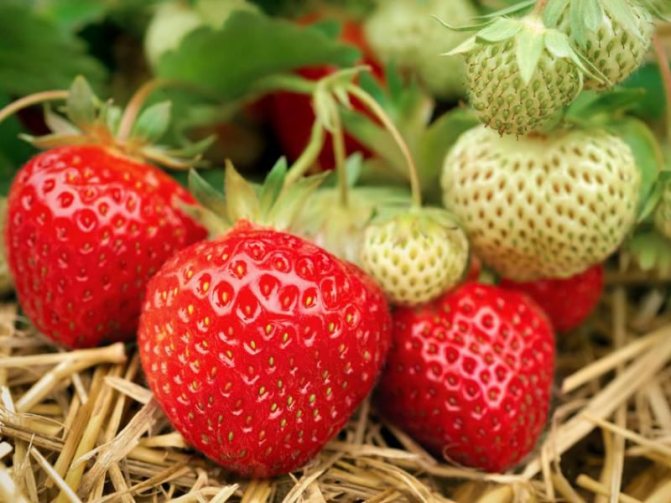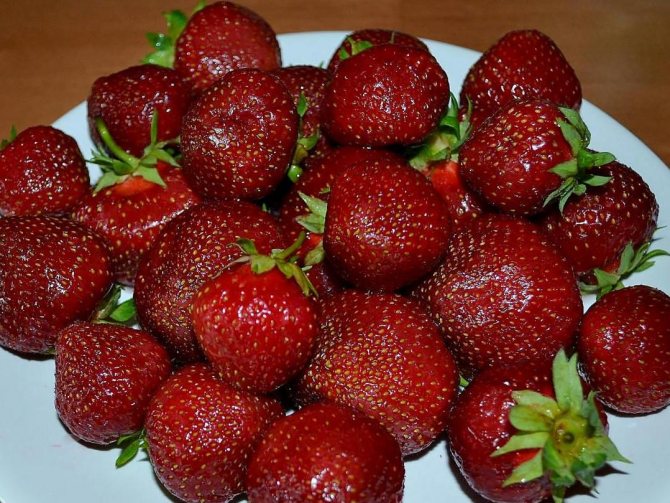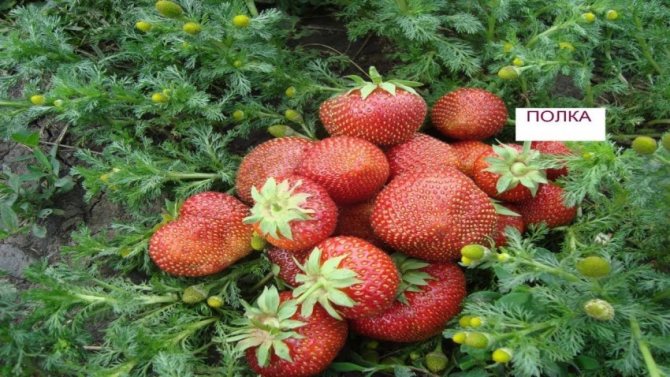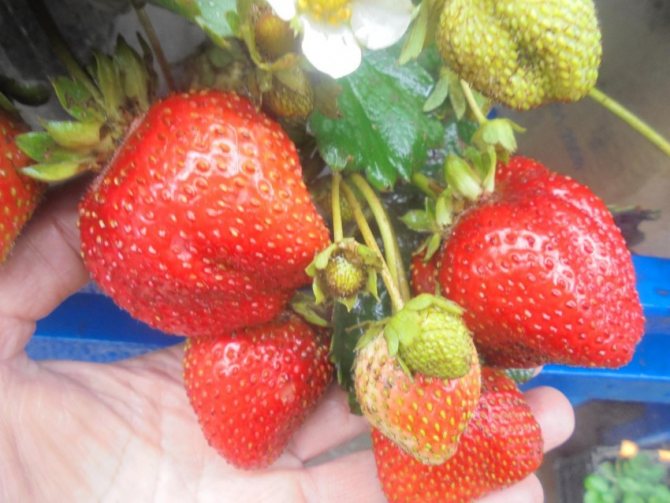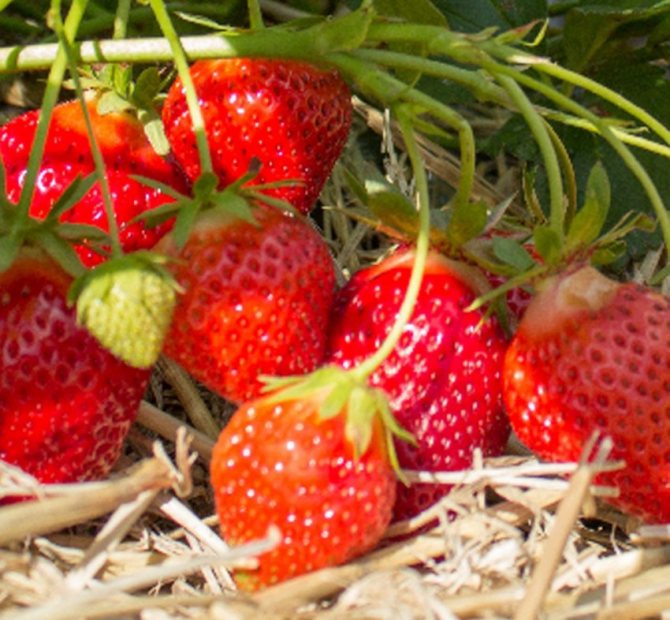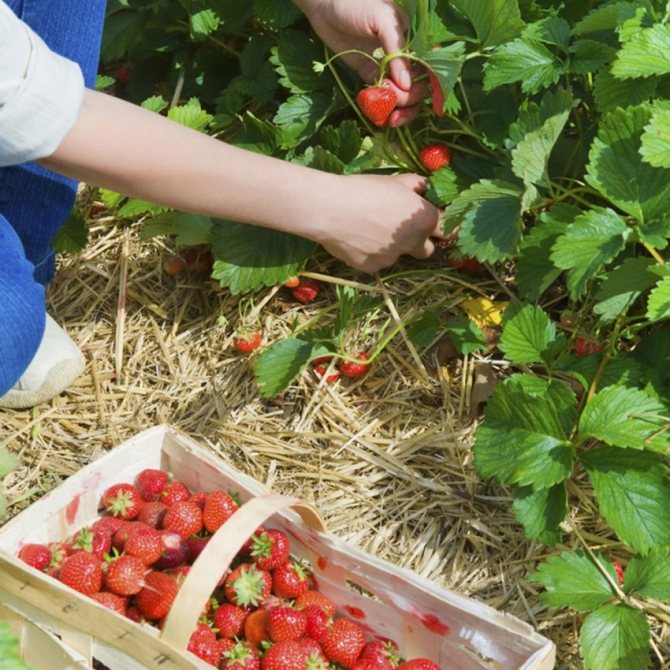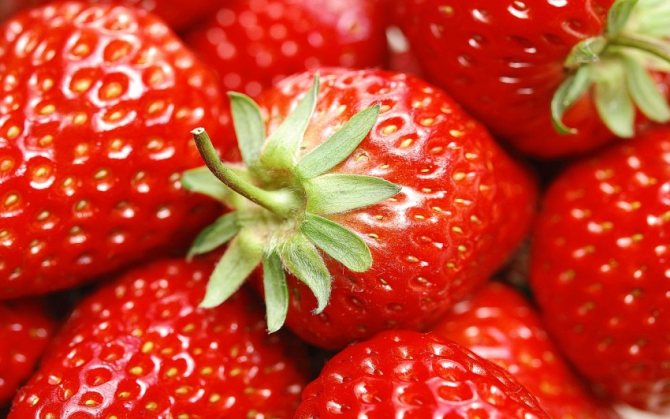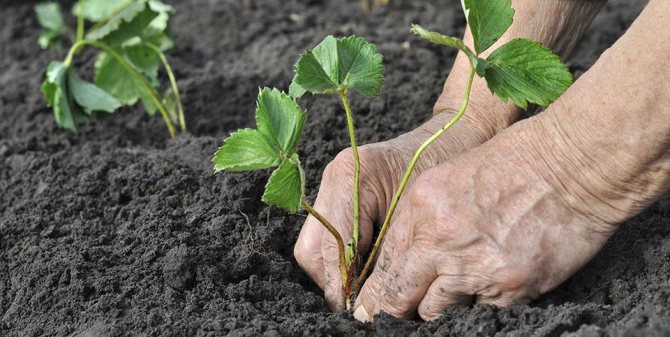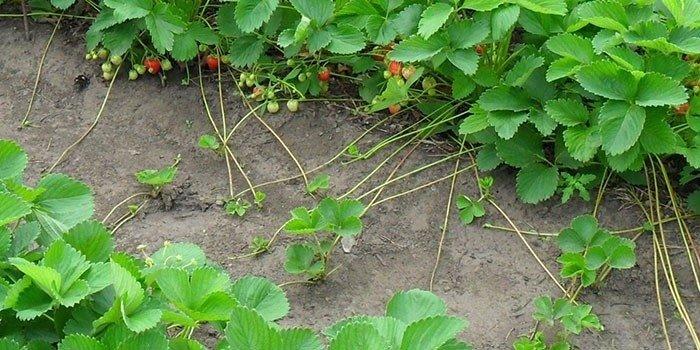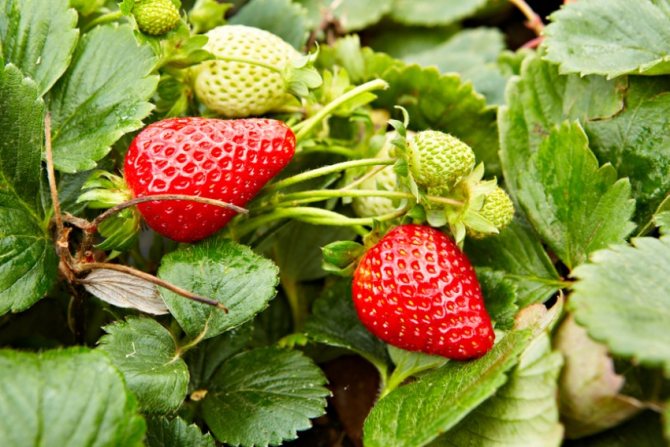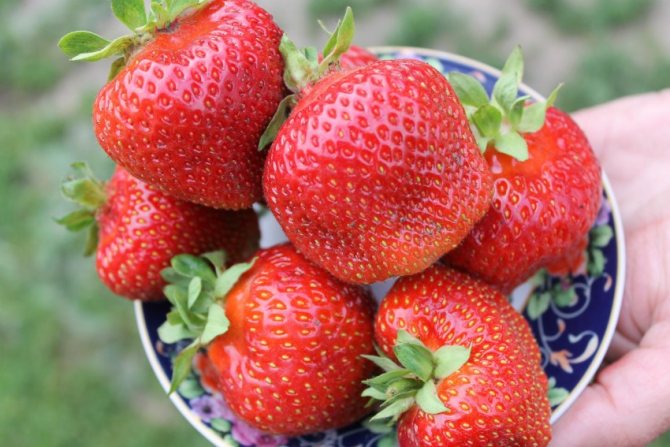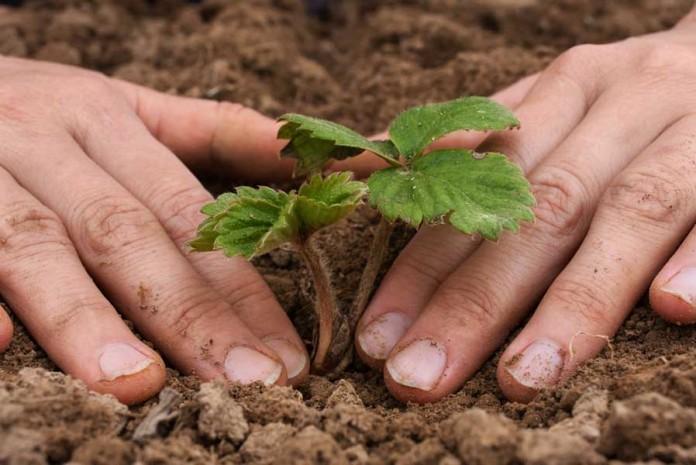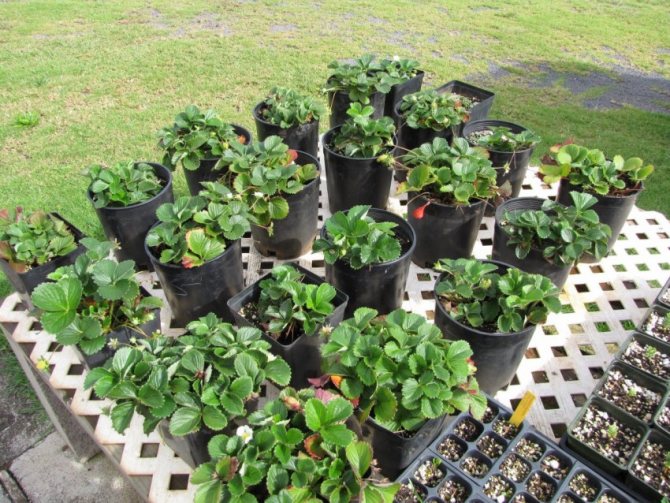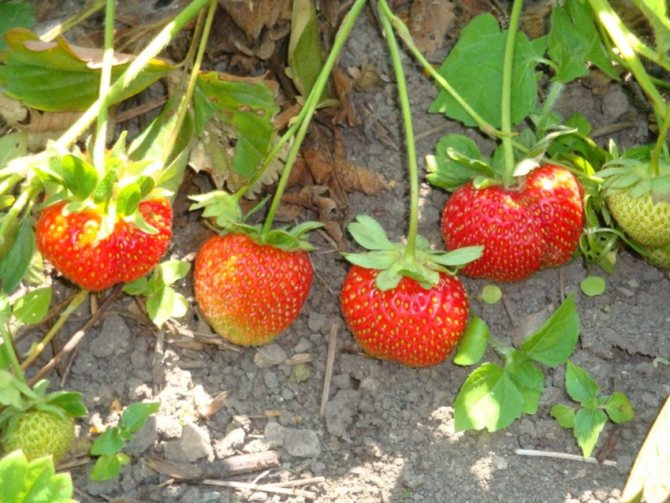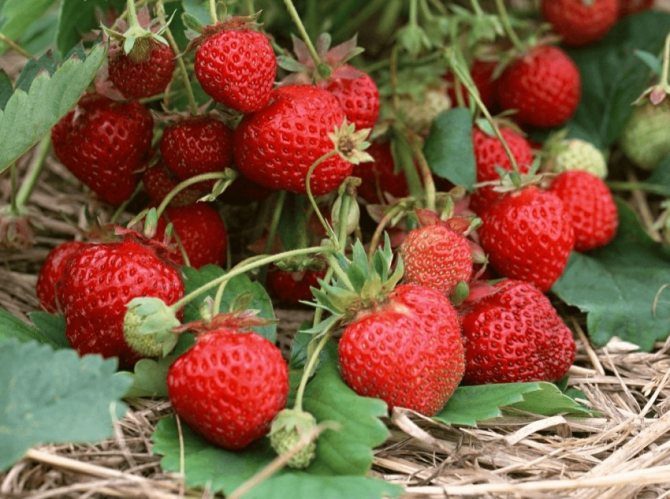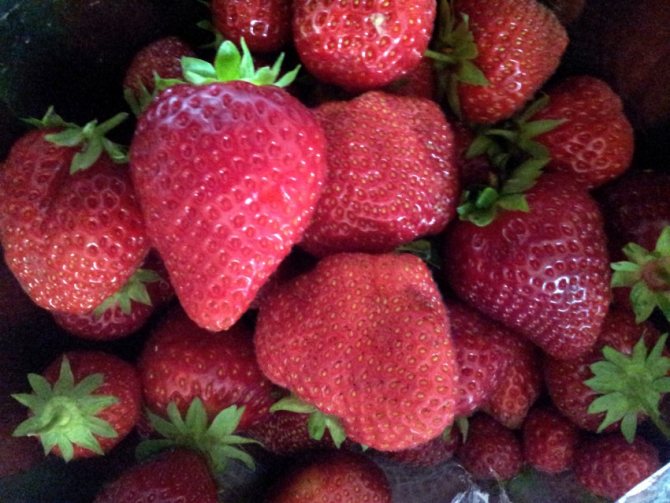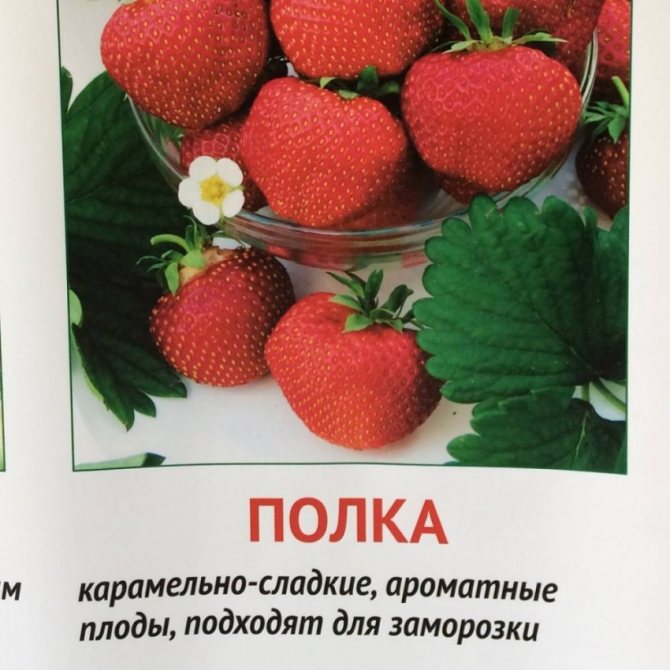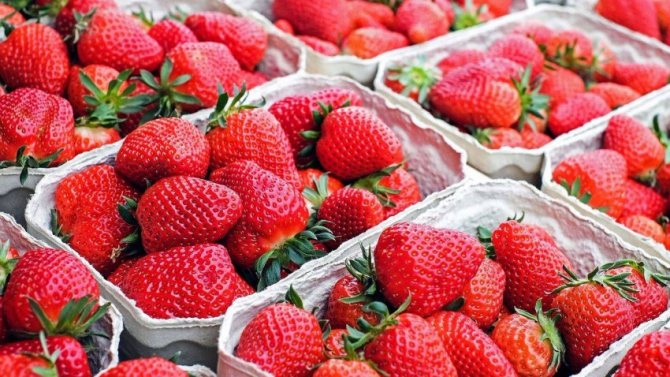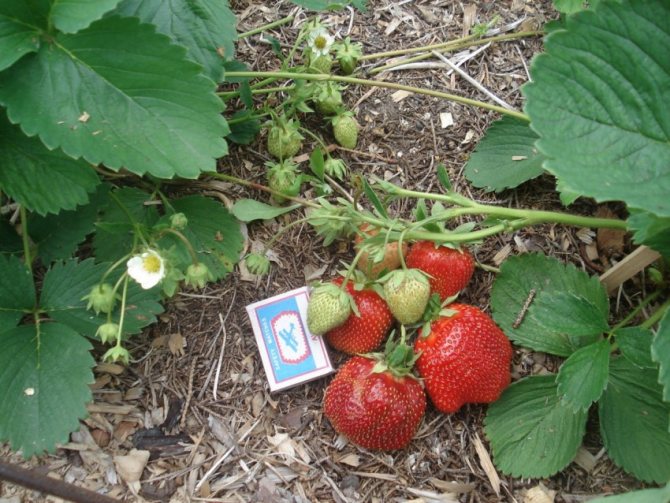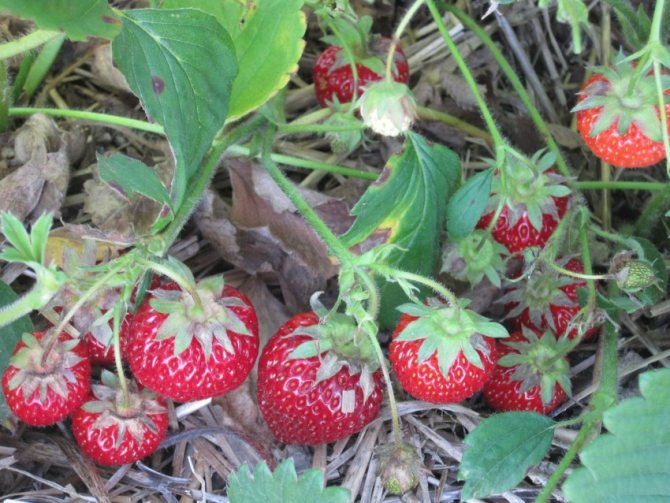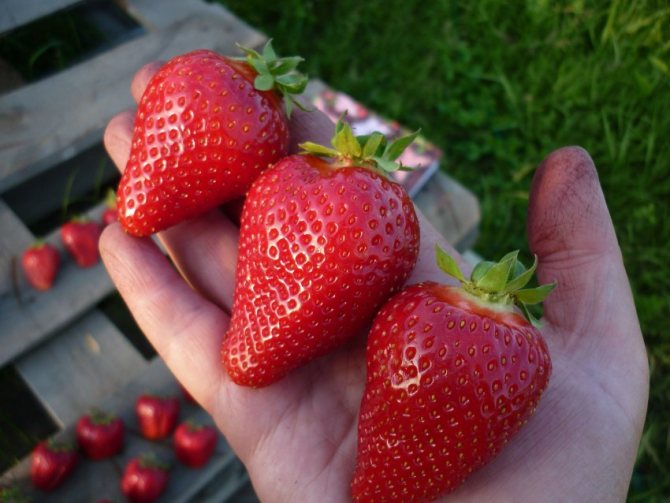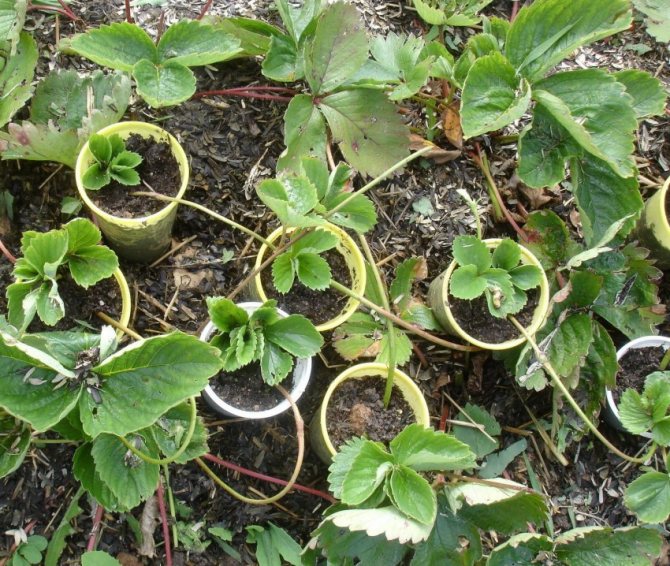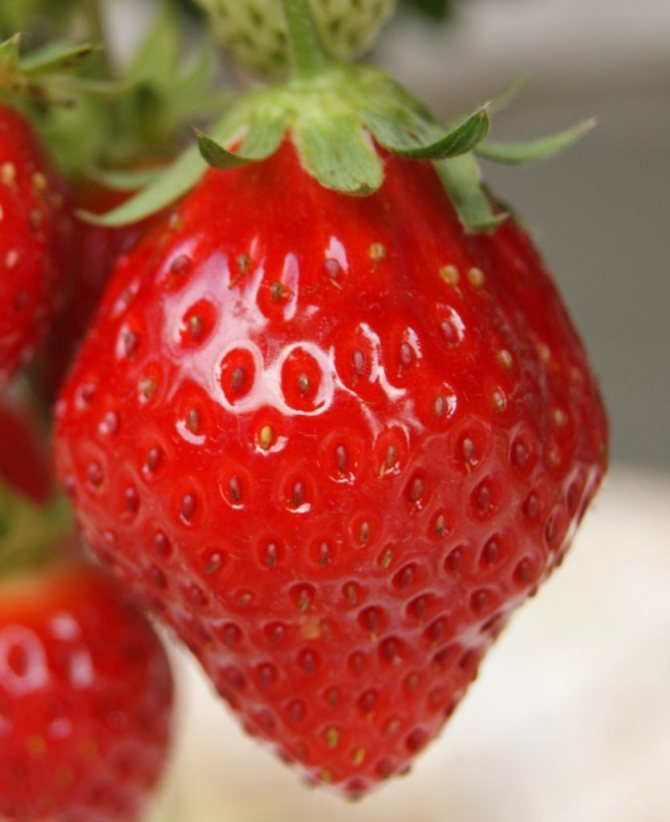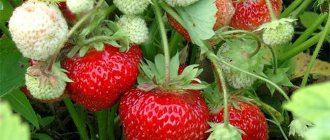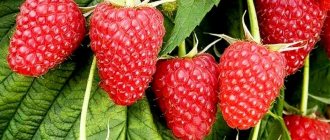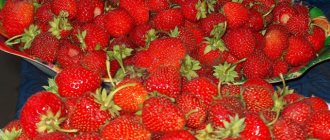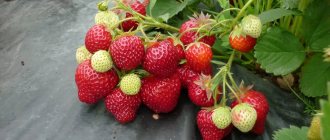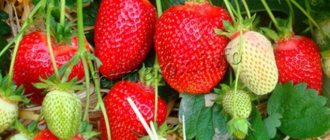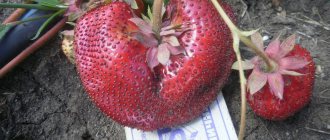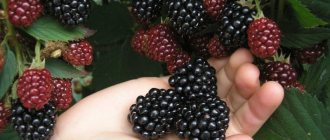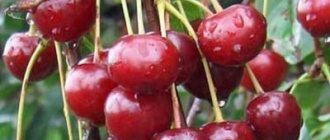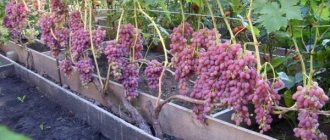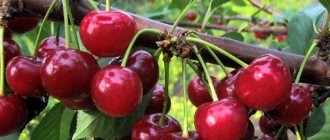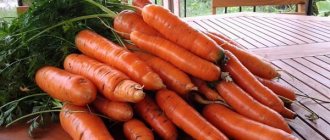Description of the variety
The Polka variety was bred by Dutch breeders and is recommended for cultivation in the forest-steppe zone. In Russia, it is most common in the Urals and Siberia.
The assortment is distinguished by long flowering and extended fruiting; it is included in the mid-season group.
Bushes
Polka bushes are compact, low, up to 15 cm. There are many leaves, stems are thick, powerful. A large number of strong peduncles keeps the berries of medium size in weight. There are practically no barren flowers. The adaptive ability is high, has a tendency to overgrowth.
Berries
The berries turn from green to red, which determines the state of technical maturity, then gradually darken, gaining taste and aroma. When fully ripe, the fruit is conical in shape, dark red in color with a beautiful gloss. The maximum weight of berries is 60 g. The first berries can be much smaller - about 35 g. By the end of fruiting, the fruits also become much smaller.
The pulp is juicy, light pink in color, without voids. The second wave of harvest produces not so uniform berries, but the taste remains excellent. In addition to the sweetness and bright aroma of strawberry, there is a pleasant aftertaste of caramel.
Polka berries can be frozen, dried, made jams and compotes. They do not lose their shape and color from heat treatment. In jam, candied fruits and confiture, the aroma is even more enhanced. Tasting score 4.9 points out of 5
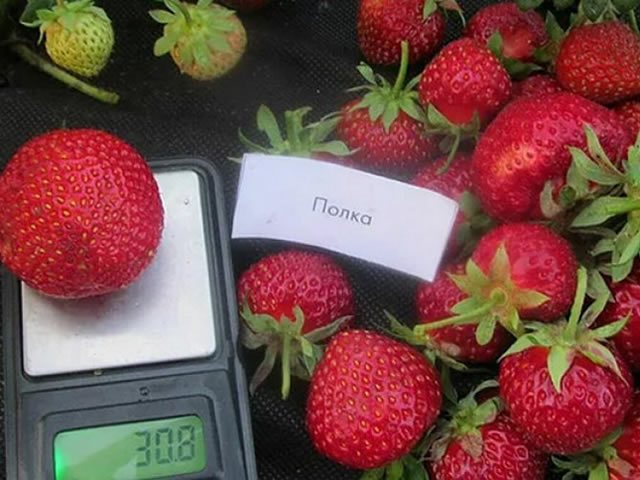
Yield
In terms of yield, Polka is not among the leaders. The first wave of the harvest is harvested in mid-June, then the plant actively bears fruit for about a month. The last berries are smaller, especially if watering was not enough.
On average, 1.5 kg can be collected from 1 m2. strawberries. Productivity is stable. The palatability improves if the summer is sunny. The variety shows good results in the open field and in greenhouses.
Reproduction methods
The Polka strawberry variety produces an average number of mustaches for breeding. Seedlings for growing strawberries should have a well-formed root system with a length of at least 5 centimeters and two to three leaves. Usually it is taken from a bush no older than three years, from the first regrown sockets. If you did not prepare the seedlings yourself, then carefully look at the color of the roots.
In young plants, they are bright yellow, and in old ones, they are dark. In addition, the roots of young bushes grow immediately after the leaves, and the old ones have a dark rhizome. Planting a plant that is already several years old does not make sense, except when it is of value to you. For example, you got one bush of a rare variety and are going to breed it.
You can plant bushes for seedlings, hiding them under agrofibre or film. The microclimate there will allow the bush to root well and give healthy offspring.
Strawberry Polka reproduces by tendrils and seeds. Both methods are effective, but more often gardeners use the first option. They take the healthiest bush, cut off a healthy mustache from it, and plant it in the ground in the standard way. Seeds are bought when there is no opportunity to purchase antennae or seedlings.
To grow strawberries, you need to find a bright place with direct sunlight. Seedlings are planted on pre-prepared beds with loose nutritious soil. It is advisable to put a little rotted manure or compost in each hole.Garden strawberries The regiment does not have special requirements for the soil composition, but responds well to feeding.
The variety is characterized by moderate winter hardiness and good drought resistance. However, shelter is necessary in snowless winters. You can protect plants from severe frosts with sawdust or special covering material. During the period of active flowering, it is necessary to water the plants abundantly (once a week), carry out top dressing and regularly loosen the soil.
In the summer, the soil can dry out in the sun, so it is necessary to loosen the soil so that the roots of the plant breathe.
Reproduction of this variety is carried out by rooting a mustache and replanting young rosettes. Bushes form a large number of whiskers, which makes this breeding method the main one. When growing strawberries in greenhouses, plants are transplanted in winter, and in open ground, seedlings are planted in spring or autumn, like other varieties of garden strawberries.
Seeds can also be used for reproduction, but this method of growing is laborious and requires certain skills.
Diseases and pests
The shelf belongs to varieties with good resistance to common diseases. The characteristic of the variety states that the plants are practically not damaged by powdery mildew and gray mold. However, a significant drawback of the Shelf is poor resistance to diseases of the root system and verticillosis.
The roots of Strawberry Polka can be susceptible to certain diseases.
The variety is not susceptible to pests and is practically not damaged by a tick, but it is still recommended to carry out preventive treatments once a month.
Polka's strawberries can hardly be called a new variety. Subject to the rules of agricultural technology and even minimal care, a stable yield will be ensured. You can get a large number of marketable berries with good taste, but you should not expect outstanding results from it.
a brief description of
Advantages of the variety
- stable productivity that does not depend on the weather;
- the ability to transport crops over long distances;
- high tasting score;
- individual caramel flavor;
- attractive appearance;
- frost resistance;
- mite resistance;
- will not disappear from heat and drought;
- versatility of use.
Disadvantages of the variety
The variety has disadvantages, but they are insignificant and fixable:
- in the third year after the plantation was laid, the yield falls;
- it will not die from drought, but the taste will deteriorate, the berries are large only in the first wave of collection;
- gives a lot of whiskers and grows quickly.
To neutralize these shortcomings, you need to water the Polka on time, update the plantation and keep an eye on the mustache.
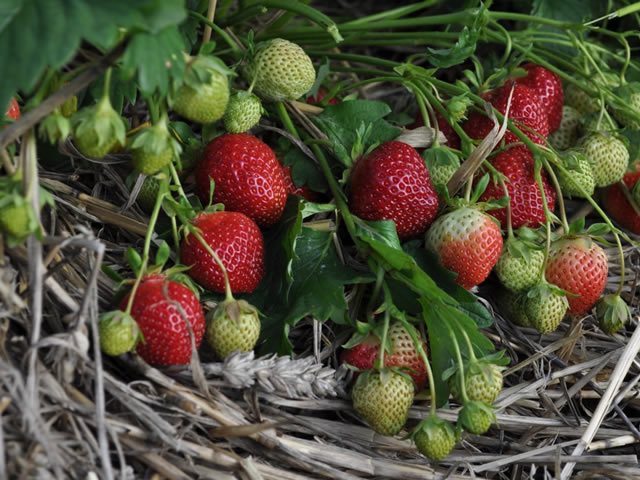

Rules for preparing strawberries for the winter period
In order for strawberries to survive the winter without problems and continue to produce crops next summer, it is important to properly prepare them for the upcoming cold weather.
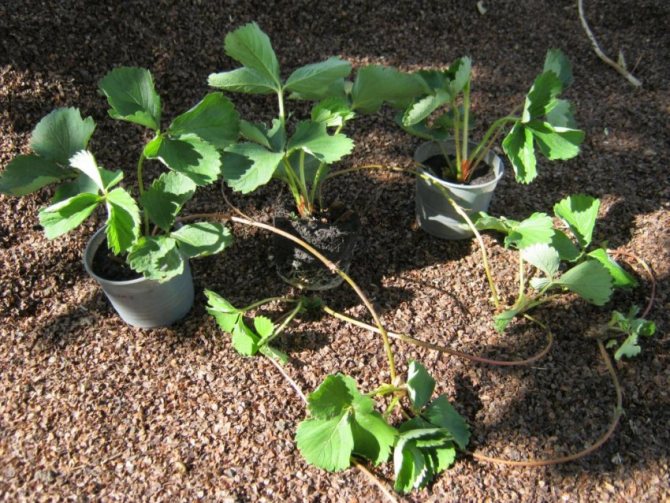

First of all, it is necessary to carefully inspect the strawberry beds and remove all dried and diseased leaves, unrooted whiskers and remaining fruits.
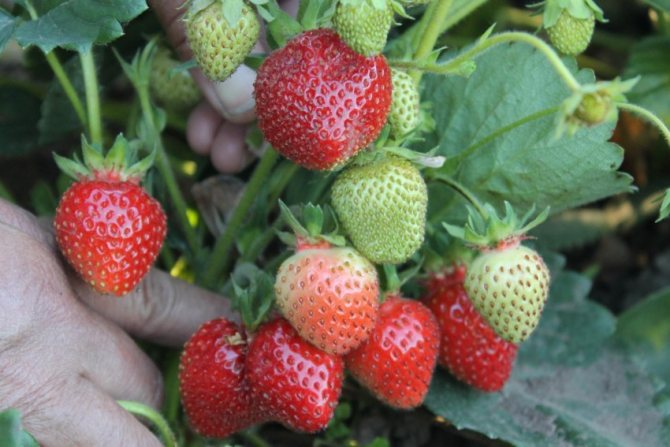

Then treat the plants, preventing the occurrence of diseases and the appearance of pests. Loosen the soil, removing all existing weeds. And finally, fertilize.
For insulation, strawberries need to be covered with dry grass, fallen leaves, spruce branches, and also with a special covering material.
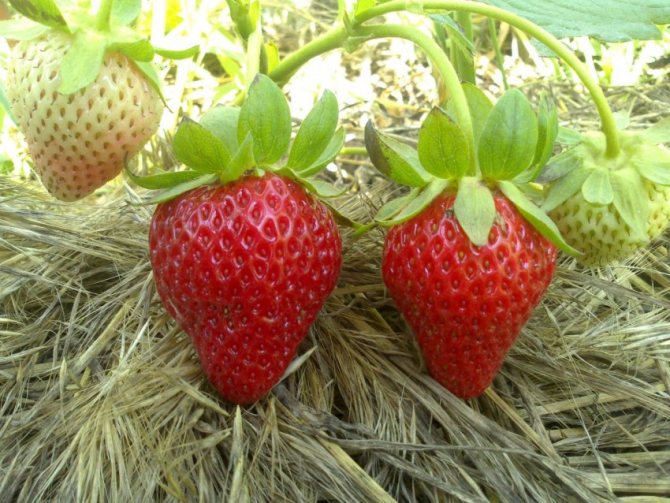

In addition, arches with agrofibre stretched over them can be installed above the garden bed - this will contribute to intensive growth in spring and earlier ripening of the crop.
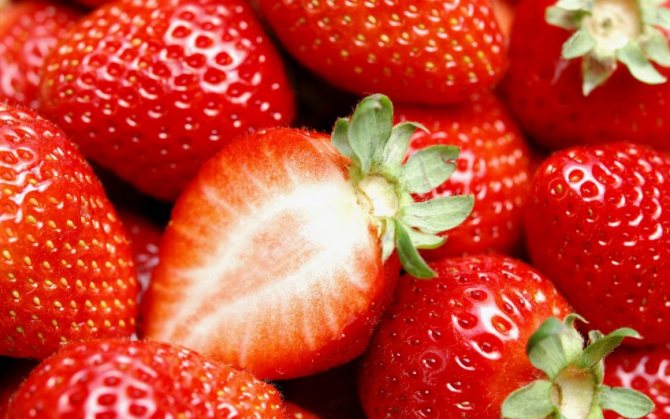

Landing
Polka seedlings take root well when planted in early spring or early autumn. In the south, you can plant in October. The optimal time for laying the berry is the end of July.Before frost, the seedlings will have time not only to take root, but also to develop, so they will actively bear fruit for the next season.
Polka loves sunny places, soil neutral in acidity (optimum pH 5.2-5.5) and fertile soil. In principle, these are standard requirements for any type of strawberry.
It is advisable to fertilize the garden well with organic matter during digging. Depending on the degree of soil fertility, add 8-10 kg. manure and 200 g of wood ash per square meter of land. Lime or dolomite flour is added to neutralize acidity.
Polka bushes are not spreading, so planting holes can be prepared at a distance of 25 cm from each other. Given the increased formation of whiskers and the need to update seedlings, they are planted with long narrow ribbons. Leave a distance of 60 cm for an additional row, which will be formed in the future from outlets. Rows, for more uniform illumination, are located from north to south.
Young plants need regular watering. In hot weather, shade from sunlight is required in the first two weeks after planting
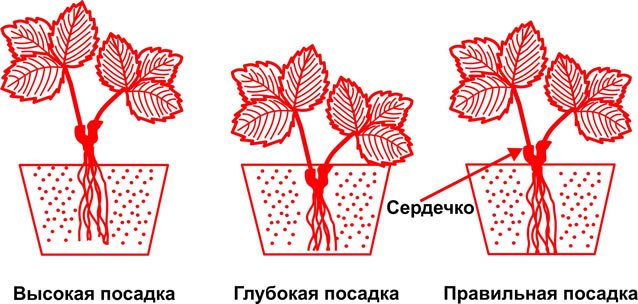

Site preparation
Preparing the soil for strawberries should be done in advance. It includes clearing and digging a place for future planting. It is imperative to do the following:
- Clear the planting area from weeds and debris;
- Dig the soil to a depth of about 30 centimeters;
- Loosen the top layer of the earth and level the area;
- Apply the necessary fertilizers.
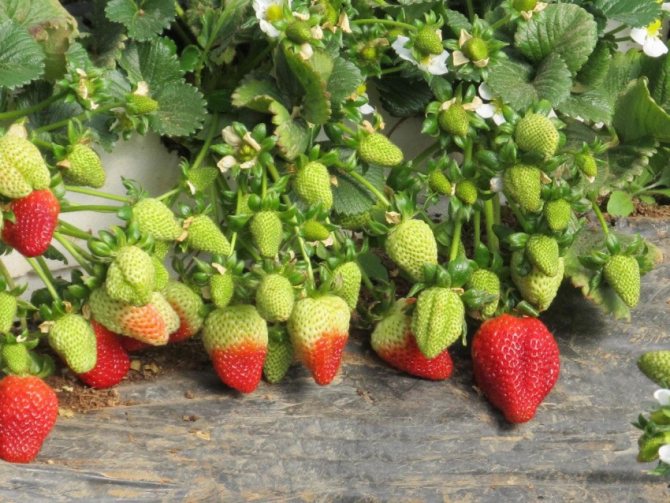

For the Polka variety, a planting in two or three rows is considered the most suitable. With this planting scheme, it is much easier to take care of the plants and harvest in the future.
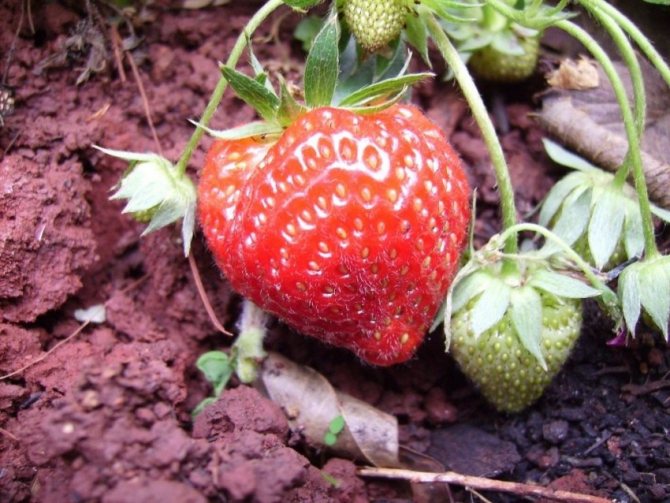

The gap between the rows should be 50-60 centimeters, and the distance from one bush to another should be at least 35 centimeters.
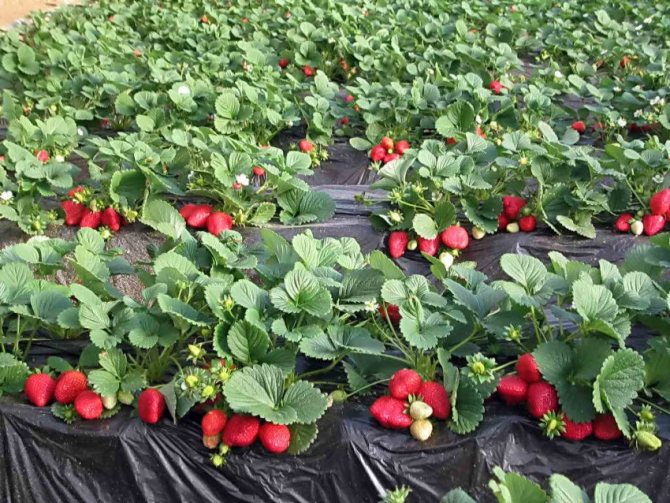

Growing and care
Garden strawberry Polka does not require much attention to itself, but for good yields, you should follow the agricultural techniques adopted for most berry crops. There are also features, one of them is to update the planting every fourth year.
Polka is one of the parents of the Sonata variety, which in Europe is considered the standard for greenhouse cultivation.
Watering
Polka garden strawberry loves watering, but without waterlogging. Irrigation is carried out as the soil crust dries up. It is convenient to water the crop by equipping a drip irrigation system.
For stable yields, regular watering is especially required during flowering and fruiting. In dry and hot weather, the frequency of watering is 2 times a week.
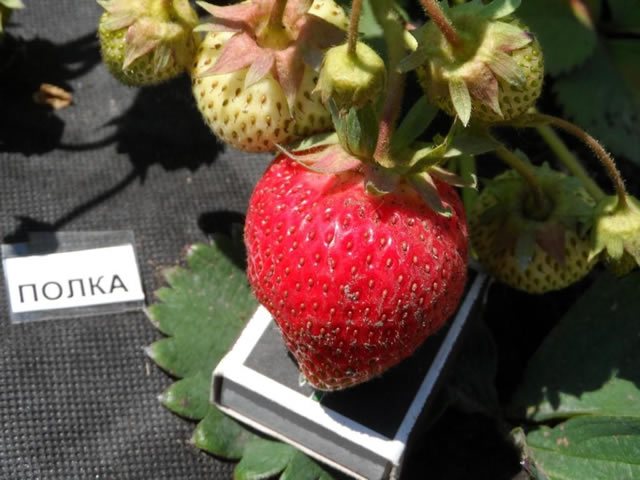

Loosening, weed control
Breathable soil stimulates the growth of strawberry bushes and promotes stable fruiting. The next day after watering, shallow, gentle loosening (no deeper than 3-4 cm) is performed to remove the crust. Weeds attract pests and spread disease, so care must be taken not to clog the beds. The use of black agrofibre as mulch gives a good effect.
Mustache removal
The cultivar has a high ability to formulate. To prevent the bushes from depleting, you need to regularly trim off excess mustache.
Top dressing
Top dressing is carried out at least twice a season:
- at the beginning of summer with complex mineral or organic fertilizers with a high nitrogen content, for active growth of green mass by bushes;
- in the fall of 10 g of urea, 15 g of superphosphate, 20 g of potassium salt per 1 m2 or a glass of ash and a tablespoon of dry chicken manure.
During the flowering period, irrigation of strawberries can be combined with the introduction of complex fertilizers with a set of useful microelements (a tablespoon per 10 liters of water). This contributes to the formation of immunity to diseases, increases the yield, makes the taste and aroma of the fruit brighter.


Pest and disease control
Polka is resistant to powdery mildew, but can develop verticillosis, which affects the root system. Pathogenic microorganisms gradually invade the entire plant.The insidiousness of the disease is that the symptoms appear at the stage when it is no longer possible to save the bushes.
Therefore, it is necessary to carry out preventive measures:
- Before planting, the roots of young seedlings are treated in a manganese solution.
- In early spring and autumn, strawberries are sprayed with a 1-2% solution of Bordeaux liquid.
Experienced strawberry gardeners have a separate inventory so as not to transfer dangerous diseases from other crops.
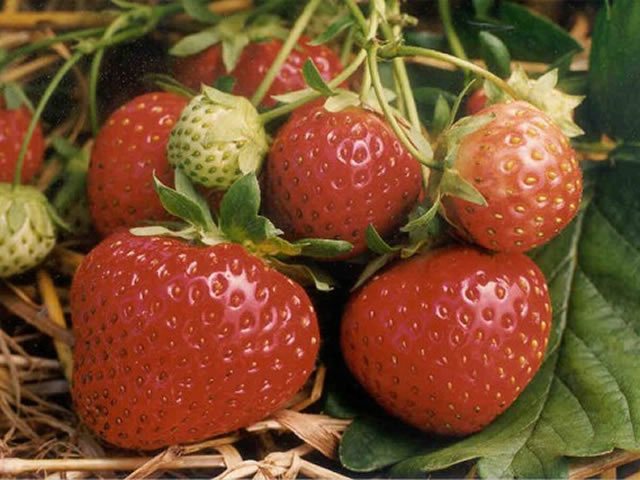

Preparing for winter
In the south and in central Russia, the variety does not need shelter. In more northern regions, strawberries tolerate wintering well under a layer of mulch made from straw, coniferous spruce branches.
Russian specialists carried out tests for winter hardiness of the variety in the Bryansk region. Polka showed itself in terms of its resistance to cold weather as a medium-hardy variety.
Secrets of high yields
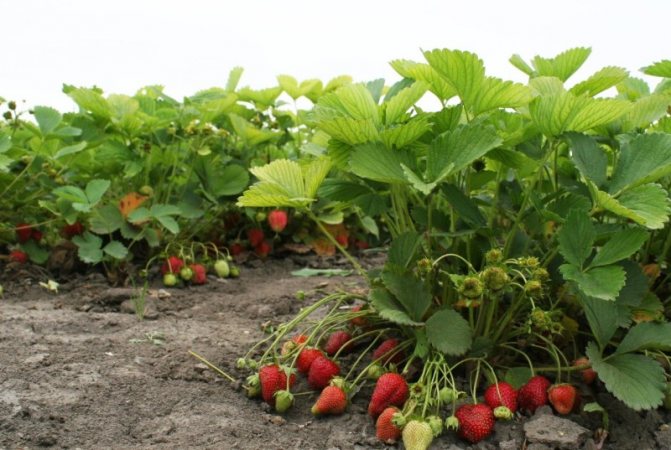

The shelf is one of the most unpretentious varieties, for which it is loved by many gardeners. But nevertheless, some features of its biology must be taken into account, otherwise a high yield will not be obtained.
Landing
Due to the powerful bushes and high spacing during planting, the distance between adjacent bushes in a row is recommended to be maintained at 30-35 cm. At the same time, the row spacing remains standard: 40-45 cm.
But usually in the plantations of the Shelf, working belts of 3-4 rows are formed, between which they leave a free space of 1-1.2 m. This arrangement facilitates both plant care and harvesting.
It is recommended to plant the Shelf from the second decade of August to the beginning of September. At an earlier date, the planted seedlings are often exposed to the summer heat and may die; at later planting dates, there is a risk that the plants will not have time to form fruit buds.
Spring planting is also practiced, but in this case, the peduncles on young plants must be completely cut off. The harvest from such a plantation can only be obtained next year.
Care
The shelf does not like thickening and reacts to it by reducing the yield. Therefore, many farmers grow it on agrofibre. On small private plantations, experienced gardeners mulch the plot immediately after planting.
Straw is considered the best material for mulch, although there are other options: chopped hay, sunflower husks, millet, buckwheat, etc. The mulch layer not only inhibits the growth of weeds, but also retains moisture in the soil - the main source of a high yield of berries.
Otherwise, the care is standard: timely loosening of row spacings, removal of sprouted weeds, top dressing and preventive treatments against diseases and pests. Upon completion of fruiting, sanitary pruning of plants is carried out.
Watering
During flowering, fruit formation and fruiting, the Regiment is very sensitive to lack of moisture in the soil. Moreover, he reacts to such a shortage not so much with a decrease in yield, but with a deterioration in the taste of berries.
The best option for growing Shelves would be to organize drip irrigation. If such an organization is impossible or not advisable, then it will have to be watered manually: often and abundantly. The idle watering rule: you need to water as much as the soil can absorb moisture without turning into a swamp.
Top dressing
The scheme of feeding strawberries The shelf is standard: when planting - the introduction of organic fertilizers, in early spring nitrogen fertilizers and mineral complexes are applied, during flowering, the emphasis is more on complex foliar dressing with a minimum nitrogen content.
In a two-year growing cycle, after the completion of the first year of fruiting and sanitary pruning, the plants are fed with full NPK to help them develop the maximum number of fruit buds for the next season.
Preparation for wintering
Like all Dutch varieties, Polka is not highly frost-resistant, so it is better to cover its plantation for the winter.In small areas, strawberries are covered with a layer of straw or dry fallen leaves, and on top with additional plastic wrap.
But a better and more reliable shelter is agrofibre. The only thing to consider is that you need to use a material with a density of at least 30 g / m² for the shelter.
I will share a little trick I personally tested: the use of two layers of agrofibre with a density of 30 g / m² for covering strawberries gives better results than using a covering material with a density of 60 g / m² in one layer - the presence of an air gap between the two layers affects.
Testimonials
Of the varieties of garden strawberries, I have two favorites - Khonya and Polka. Honey pleases with early ripening, Polka of medium terms, at the same time fruitful and tasty. The combination allows you to get a long berry conveyor.
I am very attracted to Polka by its amazing taste and aroma, the possibility of rapid reproduction, the duration of fruiting.
It is problematic to grow this variety in the south, where it will require increased watering and even shading, otherwise the yield will be low, the berry is small.
Strawberry variety Polka (Polka)
The shelf is a non-renovated medium-ripening strawberry variety. It was bred by Dutch breeders in 1977 by crossing the Induka and Sivetta varieties. Differs in good taste and excellent presentation of berries, high drought resistance and unpretentious care. Strawberries are suitable for cultivation in Central Russia, Ukraine and Belarus, popular in the Baltic countries.
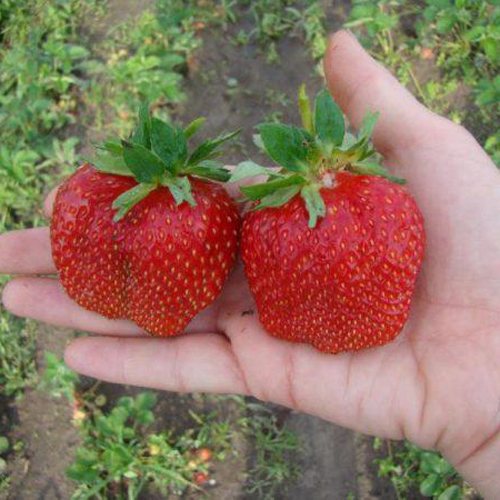

The plant is of medium height, vigorous, looks very compact. Whiskers are abundant; in the heat, the number of whiskers decreases. The leaves are large, medium-wrinkled, bright green in color. A feature of the variety is that the leaf has four or five lobes. By the way, this varietal trait was passed on to the descendant of our heroine - Sonata (Polka x Elsanta). Strawberry flowers are white. Peduncles are located at the level of leaves, under the weight of the fruit they are laid on the ground.
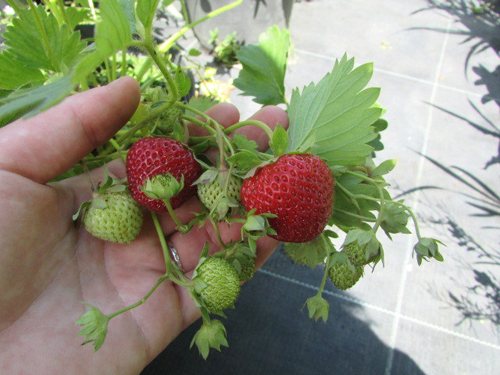

The berries are conical in shape, sometimes with a flattened tip. The skin is bright red, shiny, at the stage of full maturity it acquires a dark brownish tint. Fruits, as they ripen, are evenly colored, starting from the sepal. The pulp is light red in color, dense, juicy, without voids, with a pleasant aroma. Berries of the Shelf have an excellent taste, it is predominantly sweet, but there is also a slight appropriate sourness. There are also notes of caramel in the taste palette.
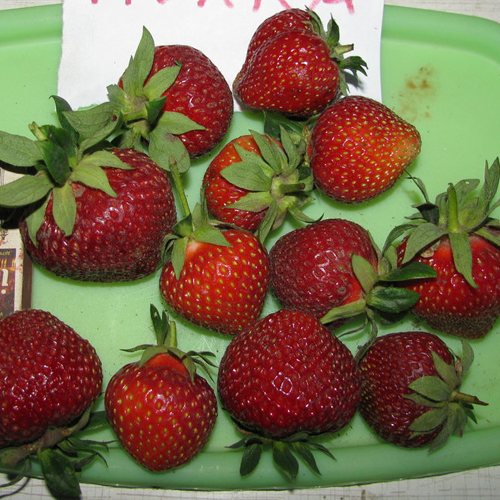

Strawberries are versatile in use, especially good fresh, suitable for any kind of processing, and suitable for freezing. Due to the dense structure of the pulp, the berries of this variety perfectly tolerate transportation, do not wrinkle and do not flow, while maintaining an excellent appearance. It is worth mentioning that the Shelf is famous for its uniformity of fruit shapes, which makes it especially attractive to buyers in the market. But it should also be said that the fruiting of our heroine is unstable, and after the first harvest, the berries begin to shrink, so there is no question of evenness of fruits by weight.
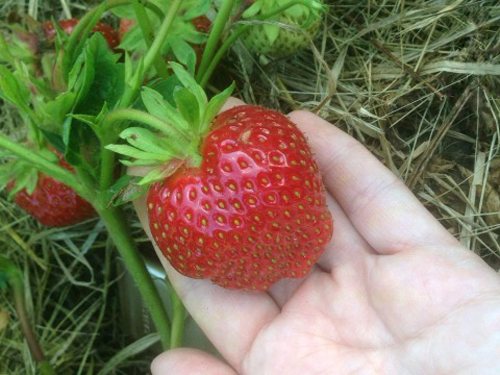

The average weight of berries is about 30 grams, during the first harvest, the indicator fluctuates at the level of 35-40 grams, the largest specimens weigh 50-60 grams, with subsequent harvests the weight gradually decreases, reaching 20 grams or less. It is worth saying that many gardeners are unhappy with the size of the berries of this variety, their weight often does not correspond to the declared one. However, the weight of the fruits is influenced by agricultural technology, as well as the age of the plants and the weather conditions of the season.
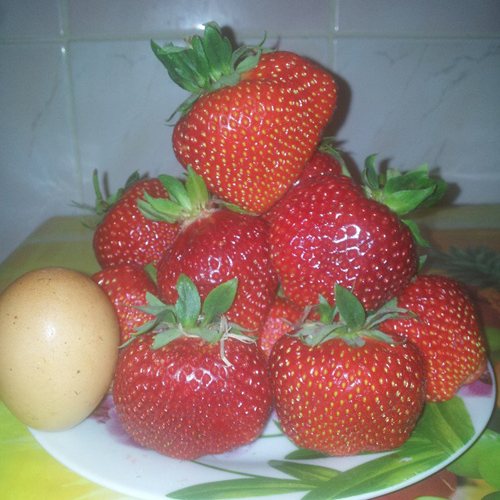

Strawberries ripen on average, around mid-June, but may start bearing fruit sooner or later, depending on the growing region and weather conditions. The yield at Polka is average, one might even say very low - about 350-400 grams of fruit per bush, about 1.2-1.3 kg per square meter.Some sources state that the yield of strawberries can reach 2 kg per plant, but this information is very controversial and most likely incorrect. It should be understood that the variety was bred for a long time, moreover, it is not repaired, therefore it cannot compete with the modern "giants" of the strawberry market. And the yield of 2 kg per bush is already a very serious indicator, which not every "giant" can produce. In addition, according to the reviews of gardeners, our heroine is revered for her other characteristics, and the amount of harvest is not her dignity.
Plants are resistant to fungal diseases, including powdery mildew, and are also rarely affected by pests. Strawberries are moderately resistant to root system diseases. It is still highly desirable to carry out all the necessary preventive measures. Polka's winter hardiness is average; in regions with frosty winters with little snow, it requires good shelter. By the way, gardeners note that the variety is quite "tenacious" and is capable of recovering from various weather disasters, including after freezing in winter. What our heroine can bravely boast of is drought resistance and heat resistance. Even in the driest and hottest seasons, the variety feels very comfortable. However, it should be said that in such conditions the taste of the berries will deteriorate noticeably - it will become excessively sour. Also, voids can form inside the berries, and the fruits themselves will be smaller. To avoid these incidents, it is enough to simply provide the plants with regular abundant watering.
In agricultural technology, the Regiment is quite simple, but it has some peculiarities. And often gardeners refuse it, simply not being able to pick up a "key" for it. Consider the main nuances of growing and care in the list below.
- Strawberries react extremely negatively to thickening, so the bushes should be planted at a distance of at least 30-35 cm from each other.
- Planting is carried out in August, optimally at the end of July, if the weather permits - young, newly planted plants do not tolerate heat well, as well as cold.
- The variety can be grown both outdoors and indoors. At the same time, under the shelters, the Regiment will begin to bear fruit a little earlier.
- Strawberries are hygrophilous, do not skimp on watering. Just do not overdo it - excessive waterlogging of the soil threatens to increase the risk of infection of plants with fungal diseases, moreover, the berries can rot.
- It is highly advisable to use mulch, as the fruits often lie on the ground, as a result of which they can begin to rot.
- The variety does not need an increased amount of fertilizers, but nevertheless, regular high-quality feeding has a positive effect on the yield of the variety and the taste of the berries. Organic matter is introduced before planting strawberries and until flowering, then preference is given to mineral complexes, and special attention should be paid to them. The fact is that with a lack of micro- and macroelements in the soil, the palatability of the fruits can deteriorate significantly - the berries will become too sour and dryish. Foliar feeding takes place.
- A feature, and at the same time a disadvantage of the Shelf, is the rapid loss of varietal traits. So, the variety reaches the peak of its productivity in the first year of fruiting, the next year the yield decreases slightly, and in the third year it is completely nonexistent. Thus, it is advisable to grow our heroine only in a one- or two-year culture, and then renew the planting. Many gardeners, who neglect the rejuvenation of the plantation, complain about too low yields and outright trifles instead of normal berries on the bushes. Well, the problem has a very understandable cause.
Let's briefly summarize. Over the long years of its existence, this strawberry has managed to acquire a large number of positive reviews.However, we can safely say that at the moment the variety is considered obsolete. Productivity - falls short of modern standards; taste - breeders brought out specimens and tastier; drought resistance is not so important in the conditions of automated cultivation technology. But despite all this, not only gardeners, but also farmers continue to use the Shelf. Although it does not differ in stability, it does not require abundant feeding and painstaking care. Although its berries are not gigantic, there are quite a few of them on the bush, which ensures a satisfactory yield. Of course, for commercial purposes, it is better to look at a different variety, more productive and reliable. And for herself and her family, our heroine is quite suitable.
All the pros and cons: is it worth planting?
Strawberry Polka is famous for its many advantages, but some gardeners found a number of disadvantages in it.
See also
Description of Zenith strawberries, planting and care rules
To read
| pros | Minuses |
| High resistance to frost, drought | Reduction of berries by the end of the season |
| Unpretentious care | Bushes "live" in one place for up to 2 years |
| The versatility of the fruit | |
| Resistance to diseases, beetles | |
| Caramel fruit flavor |
Strawberry Shelf (Polka)
There are many varieties of garden strawberries, each has its own advantages and disadvantages. Therefore, when choosing a strawberry, you need to know its description, characteristics, see photos and read reviews of gardeners who have been involved in this culture for a long time.
Strawberry Polka is no stranger to summer cottages and farm plantations. It was created by Dutch breeders back in 1977 by crossing the Unduka x Sivetta varieties. It turns out that the variety is already 40 years old, but this does not reduce the popularity of strawberries. And how can you give up tasty and sweet berries?
Strawberry care
In general, the Strawberry Shelf is quite undemanding. To get a great harvest, you just need to remember some rules and follow them.
More about the variety
Strawberry Polka, according to the description of the variety, photos and reviews of gardeners, bears fruit perfectly in many regions of Russia and the former republics of the USSR. I fell in love with the Polka variety for its unpretentiousness and productivity.
Polka strawberry description:
- The compact bush does not differ in height and spreading. But the dark green leaves with denticles around the edge are attractive.
- The plant produces a variety of flower stalks with large white flowers. The strawberry variety Polka, according to gardeners, does not have barren flowers, they all set fruit.
- At the initial stage, the berries of the Polka strawberry variety are scarlet, in technical ripeness they become dark red. In shape, they resemble a blunt shortened cone. The skin is thin, but strong; when touched, the hand does not stain.
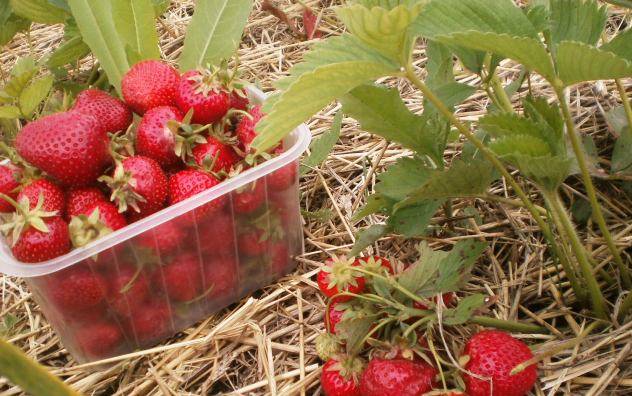

- One of the characteristics that prevents Polka strawberries from leaving the race is the unusual taste of juicy pulp: it looks like caramel. Inside, the berry is without voids, coral-red in color, it becomes lighter towards the center.
- The weight of the fruits of the Polka variety varies on the first wave from 40 to 50 grams, the rest is half less. As gardeners write in reviews, it all depends on the agricultural technology of strawberries.
- The mustache forms a lot, so as not to deplete the bush, timely cutting is required. Only the mustache is left for replacement.
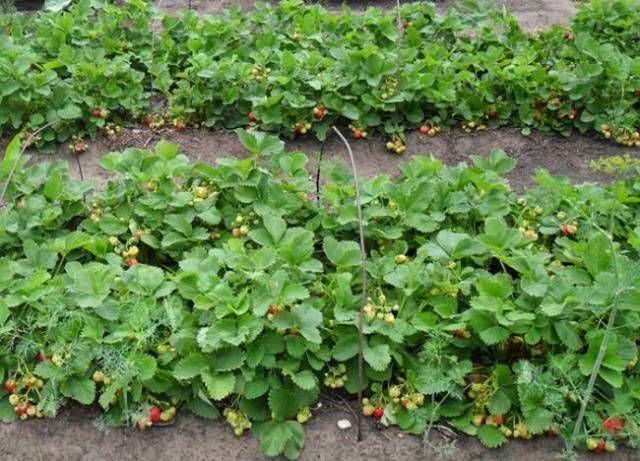

The description of the Polka strawberry variety will be incomplete if you do not tell about the processing methods. Dense, tasty berries with a caramel aftertaste are good fresh, in compotes and frozen.
Jam and compote from Polka berries acquire a burgundy color. And how fragrant jellies, jams, candied fruits are obtained, words cannot describe. As they say in the reviews, many gardeners even dry the berries, while the taste is not lost, but becomes even more expressive.
Polka's virtues
The garden strawberry Polka, which receives mostly positive reviews, has many advantages compared to other varieties:
- The plant is frost-resistant, in harsh winter conditions it survives well under a reliable shelter.
- Doesn't require much effort to grow.
- Suitable for industrial processing.
- Possesses excellent transportability.
- Practically does not get sick, although prevention is necessary.
Although the Polka strawberry is not remontant according to the description of the variety, the harvest can be obtained for a long time. You cannot call it super productive, but you can get up to one and a half kilograms from a square of strawberry beds.
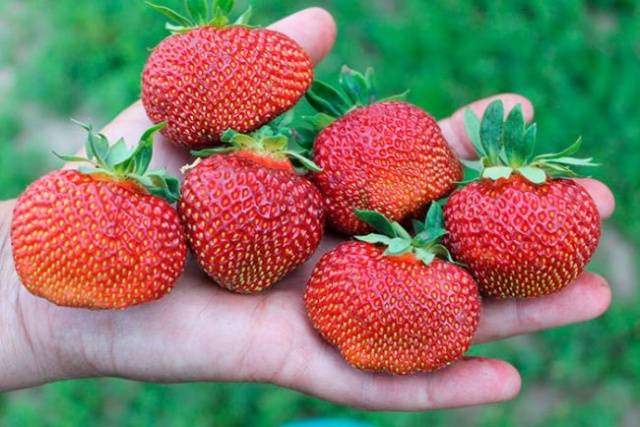

Cons Shelves
There are a few shortcomings, but in relation to our readers, it would be unethical not to point out them:
- The peculiarity of the variety is excellent fruiting in the first and second years after planting. In the third year, the berries become small. In addition, we already mentioned this in the description, at the end of fruiting, the berries are almost half the size of the first ones.
- It is necessary to constantly update the landings, which is not always convenient.
- According to the description of the Polka variety, it is heat-resistant and can withstand short-term drought. But at the same time, the berries lose in size and taste.
- Bushes grow strongly during the season.
Diseases and insect pests
Strawberry Polka is practically not susceptible to most diseases often found in other varieties. For example, it is resistant to gray mold and powdery mildew. Also able to survive garden mite attacks.
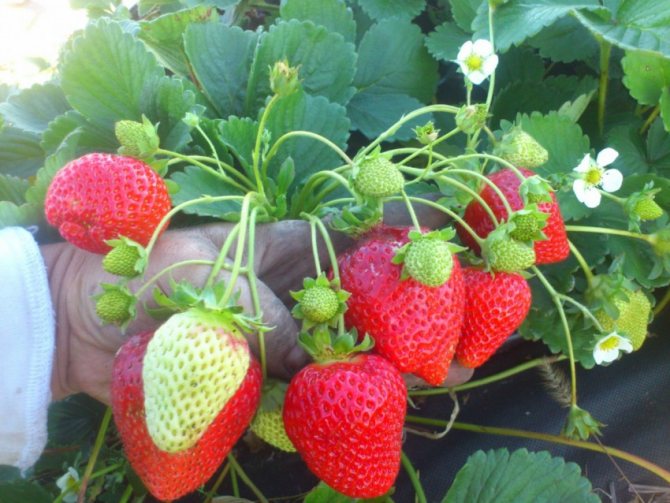

But, despite the good immunity of this strawberry variety, prevention is still necessary. It will significantly reduce the likelihood of suffering damage from those diseases and insects that the Regiment cannot cope with on its own.
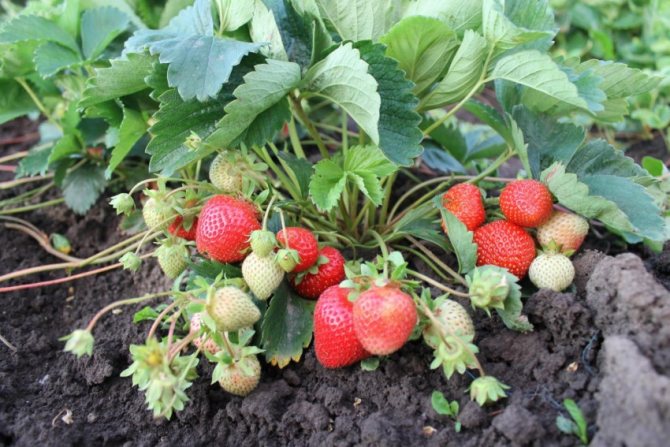

Strawberries are easily damaged by excessive mechanical stress. Therefore, before harvesting, it is better to prepare a suitable container in advance so that you do not have to move the fruits later.
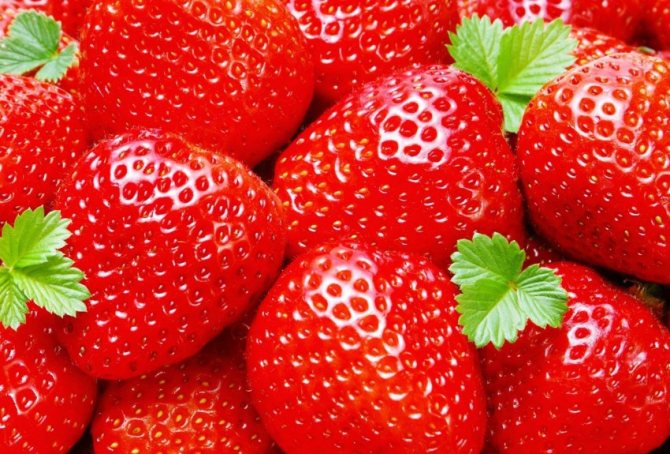

It is recommended to pick berries early in the morning or late in the evening, and only in dry weather.
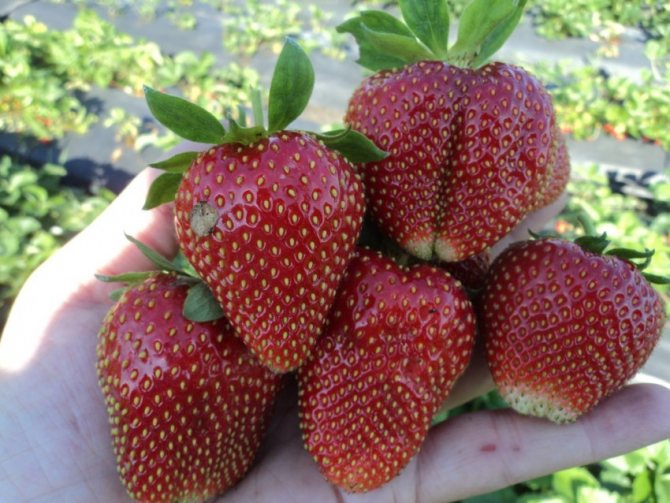

Harvested fruits can stay in the refrigerator for almost a week without losing their original properties. If longer storage is required, then they can be frozen.
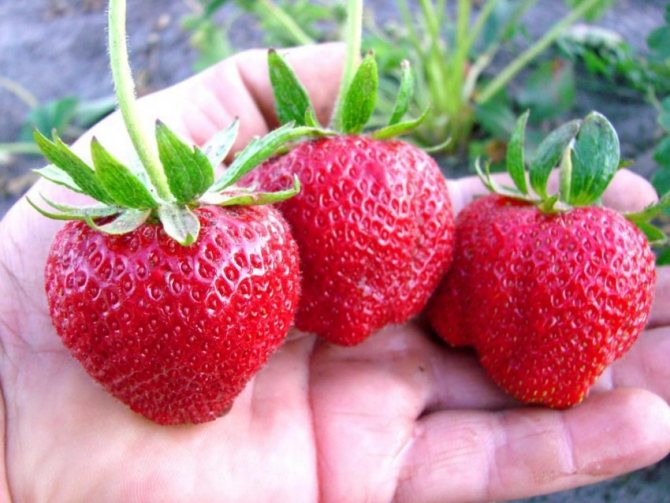

Berries of the Shelves are good both for fresh consumption and for making compotes, marmalades or jams.
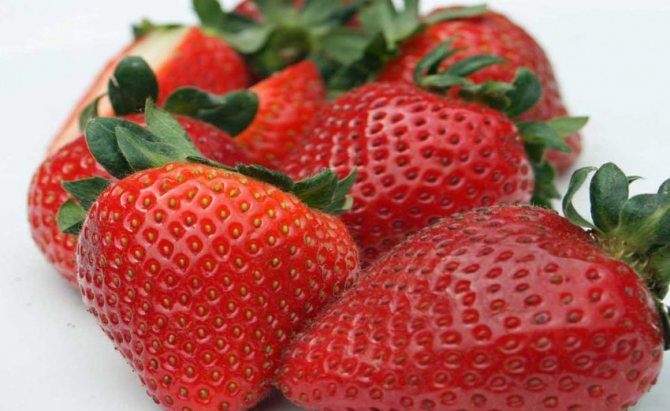

In general, the Polka strawberry variety has been trusted and popular with gardeners for more than a decade for a reason. He has many positive qualities. And most of those who have not yet had time to appreciate it will surely please.
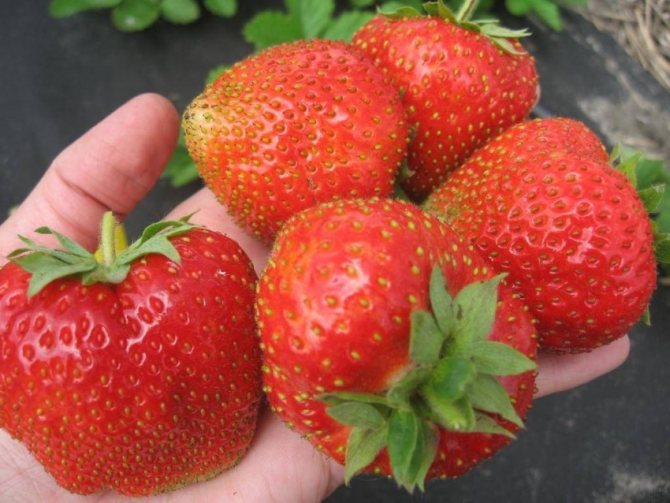

Agricultural rules
Although Polka strawberries do not require much trouble, you still need to take into account some nuances:
Many diseases are not threatened by strawberries, but problems with the root system may arise. To grow a healthy plant, you need to carefully examine the bushes.
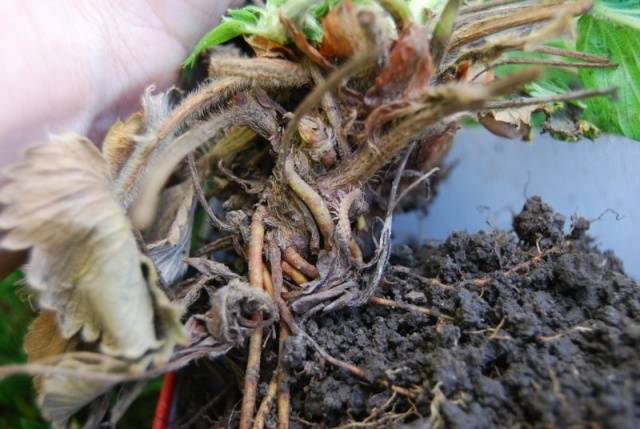

The shelf loves water, but you need to water it as the topsoil dries out. Strawberries do not like swampy soil conditions. According to experienced gardeners, a drip system is the best option. Feeding is also fed through it. It is held several times a season.
In strawberry beds, weeds should not be allowed to grow, because they can cause strawberry diseases and a breeding ground for pests.
Polka strawberries require breathable soil. This can be achieved by loosening. It is performed after watering so that a crust does not form on the surface.
Plant seedlings in well-fertilized soil.
Seat selection
To achieve the best result, the strawberry planting site should be as flat as possible. And always sunny. In the shade, the bushes will grow, but not bear fruit.
It is also best to protect strawberries from the cold wind with thick bushes or a small fence.
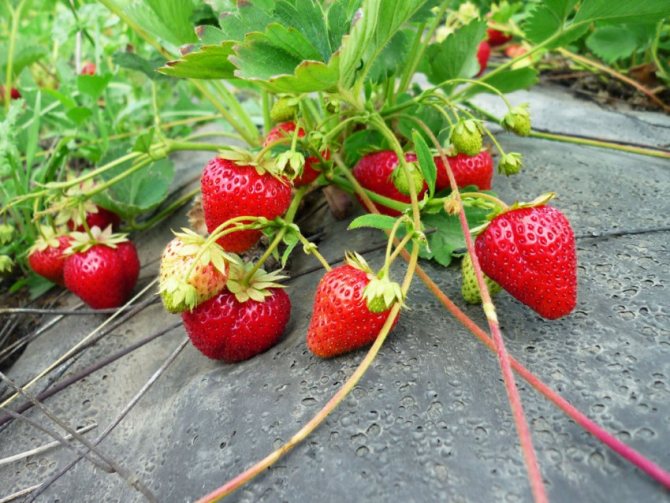

The best soil option for this strawberry variety is chernozem, loam, sandy loam or dark gray forest soil.
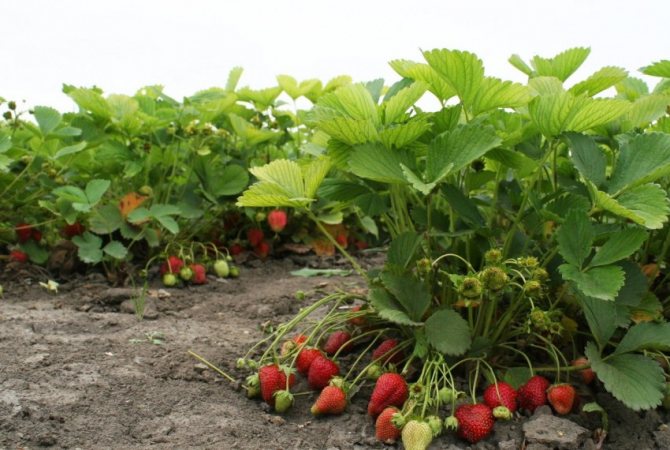

Strawberry "Shelf": variety description, photos and reviews
Polka strawberries have been widely cultivated in many European countries since the 80s of the last century.The variety is considered highly productive and one of the best berries in terms of taste; intended for amateur gardening, small and medium-sized commercial production using ecological (organic) technologies.
We will tell you about the advantages and disadvantages of the variety in the article and start with the main characteristics of the “Polka” strawberry:
| Parameter | Characteristic |
| Culture | Garden strawberry (Fragaria ananassa) |
| Ripening terms | Medium or mid-late |
| Fruiting | One-time (non-repairable) |
| Photoperiodic type | Short daylight hours |
| Yield | High: from 300-500 g to 2 kg per bush |
| Berry mass | The first - 35-40 g (maximum up to 50-60 g), the main collection - an average of 20 g |
| Fruit shape | Rounded cone |
| Berry color | Dark red, with a glossy sheen |
| Pulp | Dark red, juicy, dense |
| Tasting assessment | 4.6-4.9 points (out of 5) |
| Appointment | Universal |
| Associative ability | High |
| Sustainability | The variety is medium-hardy; relatively drought tolerant; resistant to powdery mildew; tolerant to gray fruit rot |
| Productive life cycle | 2-3 years |
| Growing regions | Recommended for the forest-steppe zone |
| Registration in the State Register of the Russian Federation | Not registered |
| Year of inclusion in the State Register of Ukraine | 2007 |
| Originator and copyright holder for the distribution of the variety in Ukraine | Plant Research International B.V. (Wageningen, Netherlands) |
Main advantages and disadvantages
Like any other crop, Polka's strawberries have both pros and cons. Although it should be noted that she has much more positive characteristics.
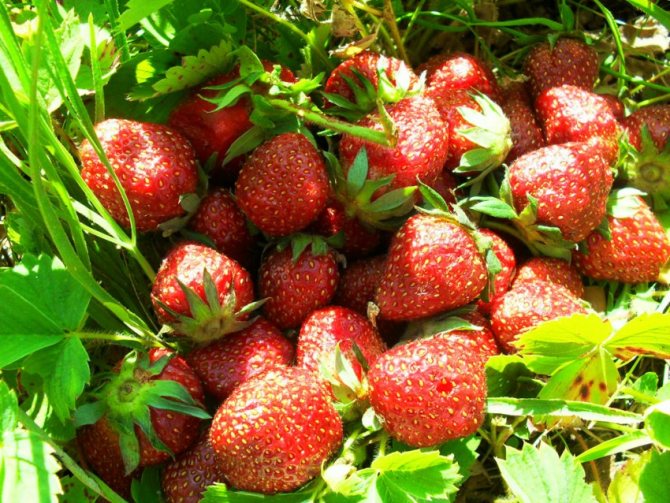

Pros:
- Resistant to cold and drought;
- Good storage safety during transportation;
- Unpretentiousness;
- Good resistance to diseases and garden pests;
- High yield for the first two years;
- Prolonged ripening for a long period;
- Excellent taste of berries;
- Preservation of shape and color of berries even after heat treatment.
Read here - Strawberry Zenga Zengana - description of the variety and features of its cultivation. Tips for choosing seed and care instructions (120 photos)
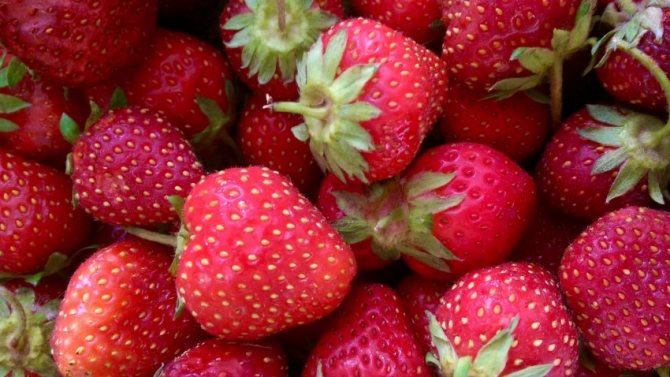

Minuses:
- Grinding berries in the last harvest of the season and two years after planting;
- The need for frequent updating of landings;
- Intense overgrowth.
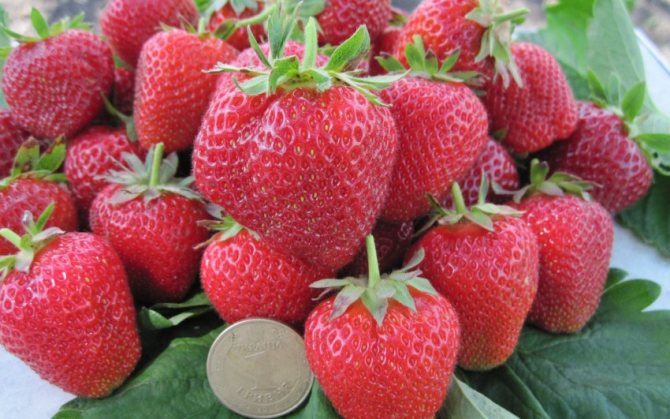

Origin and official registration
The variety was bred in Holland in 1977 by scientists and breeders of Plant Research International B. V. at the University of Wageningen by crossing Induka and Sivetta. One of the ancestors of the "Shelf" on the maternal side is the famous Zenga Zengana variety, with which it is often compared and considered superior in many respects.
In 2007, the variety was included in the Register of Plants of Ukraine as recommended for cultivation in the forest-steppe zone. It is not officially registered in the State Register of the Russian Federation, but, according to gardeners, it has taken root well in many regions of Russia, including in the middle lane, in the Urals and Siberia, as well as in Belarus and the Baltic states.
History of appearance
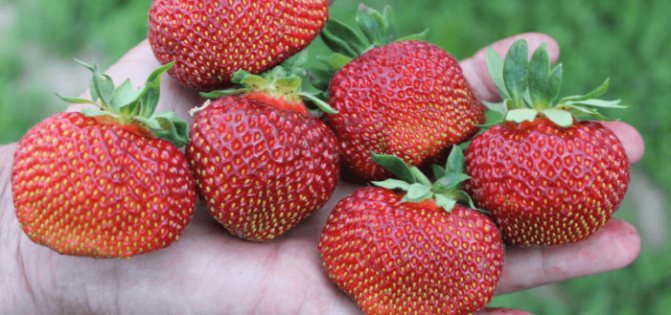

The shelf is a variety of Dutch selection, but has long and firmly taken root not only in Russia, but also in Ukraine, Belarus and the Baltic countries. Bred in 1977 by crossing Unduka and Sivetta varieties. Shelves' parents are also of Dutch origin.
The union turned out to be very successful - the "child" pleased its creators with high yield and bright taste, for a long time becoming one of the main industrial varieties not only in Holland, but also in Russia.
Today, under the onslaught of more promising novelties, Polka has somewhat surrendered its positions, but has not completely left the market, still remaining a major player in the strawberry party.
Advantages of the variety
Among the undoubted advantages of the "Shelf" should be highlighted:
- endurance and unpretentious care;
- resistance to diseases of powdery mildew, low susceptibility to gray fruit rot (yield loss less than 2%) and spider mite lesions;
- high productivity;
- excellent commercial and consumer qualities of fruits;
- the universality of their purpose.
Endurance
According to data from foreign sources, the "Shelf" is classified as especially winter hardy varieties suitable for growing outdoors under adverse weather and climatic conditions. Plant resistance to autumn and spring (during flowering) frosts is also noted.
In tests carried out in 2002-2006. Russian specialists at the collection site of the Kokinsky stronghold of VSTISP in the Bryansk region (where winters are often very cold and snowless), the variety proved to be moderately hardy in terms of the degree of freezing.
In regions with frosty (below −15 ... −20 ℃) and snowless winters, strawberry beds require shelter with organic mulch and / or agrotex.
Variety relatively resistant to summer heat and droughts, tolerates shading safely. Based on the results of field tests carried out in 2006-2009. on the irrigated area of the Samara Research Institute of Horticulture and Medicinal Plants "Zhigulevski Sady", during drought "Polka" weakly lays flower stalks and sharply reduces productivity (by 23-65%) compared to other varieties.
One of the most important conditions for obtaining good yields is abundant and regular watering during the flowering period and during fruiting (in dry weather). Experts consider it necessary to use drip irrigation systems.
Features of fruiting
The variety is distinguished by long flowering and extended fruiting. In terms of ripening, it is included in the mid-ripening group: the first harvest ripens closer to mid-June, active fruiting lasts up to 4-5 weeks, but by the end of the harvest, the size of the berries is almost halved (especially with insufficient watering).
Features of fruiting
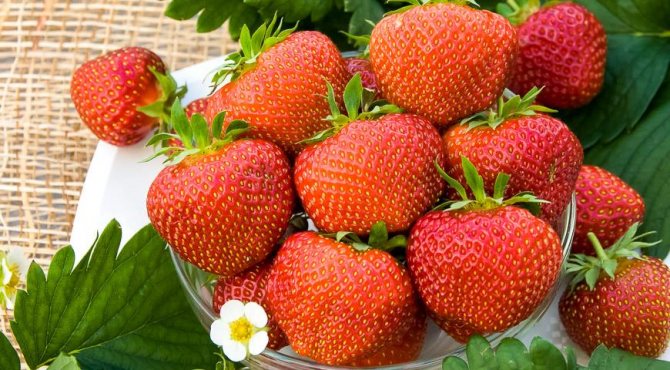

Under optimal conditions, the first Polka berries ripen in mid-June, and their mass ripening occurs in the last decade of June - early July. Fruiting lasts at least 3 weeks, and often stretches to 4-5 weeks.
The highlight of the Shelf, distinguishing it from a number of other strawberry varieties, can be considered the fact that it shows its maximum yield in 1 year after planting.
For 2 years, the yield decreases slightly, but still remains quite high. But already for 3 years, the variety is degenerating, and the yield decreases sharply. Therefore, in order to maintain high productivity of the plantation, bushes have to be changed annually or at least every 2 years.
Such a change is largely determined by the weather conditions of 1 year of cultivation. For example, in the regions of the middle zone, where the summer is relatively mild, the Regi bushes grow closer to medium-sized, but the berries remain large and sweet for 2 years. This makes it possible to grow the variety in a two-year cycle.
In the southern regions and even in the central regions of Ukraine, where in recent decades hot dry summers have already become the norm, the Shelf grows tall, but even in 1 year of cultivation, the berries are inferior in size to those grown in the middle lane, and by 2 they are even smaller, so inevitably it is necessary re-mortgage the plantation every year.
Gardeners reviews
Anatoly, 54 years old, Kamchatka
I plant two main varieties on the berry for sale: Honey (the earliest) and Polka, which ripens after him. In our conditions, the berries are very tasty and beautiful. During transportation, they do not wrinkle and do not let juice. By the end of the collection, however, they are smaller, but they are well taken for homework. The variety is excellent: unpretentious, fruitful and disease resistant.
Ivanna, 46 years old, Kharkiv region
Of all the strawberries to taste, the old Dutch variety Polka remains in the first place for us. A remarkably sweet berry with a caramel flavor and a slight sourness. She in itself is a wonderful dessert and we eat almost the entire crop at once. If it is possible to cook the jam, then the berries during heat treatment perfectly retain their shape and become dark ruby.
Selection of seedlings
Properly selected seedlings are the key to a good harvest.When choosing them, you should pay attention to several important points:
- The root should be branched, not shorter than 7 centimeters;
- Leaves are bright green, without damage or spots;
- The growth point (heart) should not be dry or rotten;
- The root collar is about 0.5 centimeters in diameter, without rot or stains.
